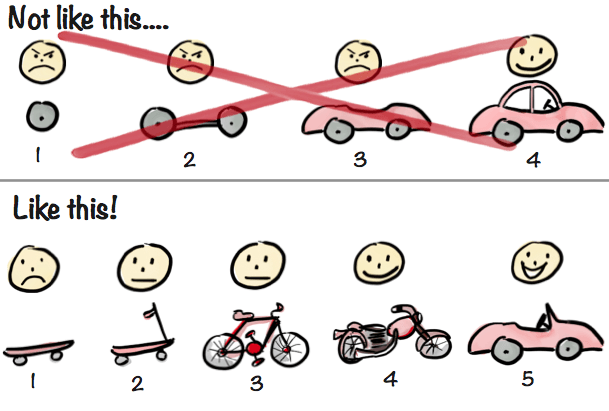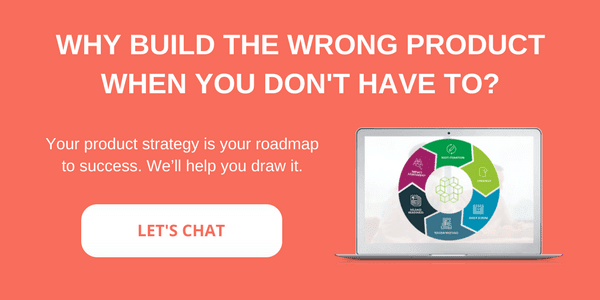When you’re a startup, it’s not enough to have a new idea. You have to be able to prove your new idea works and is viable – that you have the skills and technology to make it and produce it and that the public will want it (and maybe even pay money for it). The best first step to proving viability is to build a minimum viable product (MVP).
To help you get started, we want to share what every startup should know about building a minimum viable product before you build it – based on what we’ve learned from prototyping MVPs for clients.
The concept of building an MVP is simple. Your goal when building an MVP is to build the smallest, quickest, yet functional version of your idea – something that can be tested quickly and easily, over and over, until it works. Then, once you have the bare-bones version of what you want to make, you can scale up from there. The MVP idea was born from the Lean Startup movement. It uses the premise that entrepreneurs should develop products and businesses iteratively in small steps in order to reduce risks and save founders from overspending and overbuilding. It was first proposed by Eric Ries who used his experiences in the startup world to develop a lean way to build high-growth companies.
According to Eric, an MVP is “that version of a new product which allows a team to collect the maximum amount of validated learning about customers with the least effort.”
Sounds easy enough, right? It’s actually very easy to get it wrong. How you develop that idea is what can make or break you. Both the approach to building an MVP and then scaling it once it’s built is where many startup founders get confused.
If you’ve got an idea and are ready to act on it, here are some things you should know about building a MVP before you build it.
1. Start with customer research to understand your audience
The Lean Startup methodology is all about testing and validating the hypothesis that:
- Your solution is something your target market needs, and
- Your solution is something your target market will pay for.
After all, why sink money into developing anything if you don’t have market validation?
The first step to development is to get customer feedback before you build anything. You need to drill deep down into the problem you’re solving and find out if your solution solves the problem in a way that appeals to your target audience.
This means you really need to know your audience. You need to know how they use technology, what their preferences are, if they can they afford your solution, if they are a big enough market, what they have in common, and what their biggest pain points are – to name a few things. Your audience is going to drive your development decisions, so do your research up-front before you write your first line of code or build your first prototype.
2. Make sure your minimum viable product has value
There’s a lot of confusion surrounding what exactly constitutes a “Minimal Viable Product.” Some startups go overboard and build out too many features for too many customer segments before they get market validation. Others build too quickly and present the market with something unfinished, ugly, and extremely basic.
Yes, your MVP should include the absolute minimum features, but it should also encompass a complete customer experience. Presenting the market with a poorly designed product will only turn customers away and never give you the chance to build on your idea. Your MVP needs to have quality code, design, content and basically provide a good all-around user experience – not just a bunch of random features.
This visual drawn by Henrik Kniberg illustrates exactly what we mean.
If your target market needs a mode of transportation that gets them around more quickly than on foot, your MVP shouldn’t be a piece of what will someday become a car. That gets your target consumer nowhere (literally). Your MVP is the simplest mode of transportation that is not on foot. Once you decide that people are using your skateboard, you build something better and more efficient that better suits your customers’ needs. You keep building and iterating until you get to the car. What you can’t do is present the market with something that doesn’t solve any of their problems with the promise that someday it will.
3. Only aim to solve one problem for one audience
Another piece to building your MVP is narrowing in on whom you’re solving the problem for. While you were writing your business plan, you probably mapped out a few different segments or use cases. Your MVP does not have to provide solutions and features for each one of those segments or use cases. It needs to solve at least one problem for your main target audience.
The point of the MVP is to figure out if your hypothesis is viable – that people are in fact willing to pay for your solution. If you launch and don’t get the market validation you need, then it’s back to the drawing board. You have a product that you could easily change or scrap based on customer feedback without losing too much either way. If your launch goes well, you now have the validation you need to pitch to investors and continue to iterate.
4. Use data to figure out when to add features
Overbuilding is a huge problem for startups. It’s so easy to fall into the trap of trying to be everything to everyone. When it comes to what features to focus on next, use data to inform your decisions.
Dive into your data to give you a better idea of what to focus on building by looking at:
- Customer support data to find common questions or problems that could be solved by adding a feature
- Common feature requests from users
- App metrics to see the most commonly used functions (if you’re looking at a technology)
Every feature you release needs to solve a problem and it needs to be tested. This is the best way to avoid overbuilding and to make sure your product stays aligned with your users’ needs.
Taking your startup from idea phase to launch is a big deal. While there will likely be missteps along the way, it’s important that you build as lean as possible, so you can learn quickly from your mistakes and move on. Your MVP is your best chance for doing that.
Ready to build an MVP for your product idea? We’re here to help you flesh out your ideas and help you go from ideation to implementation. Schedule a call with us and let’s chat!








